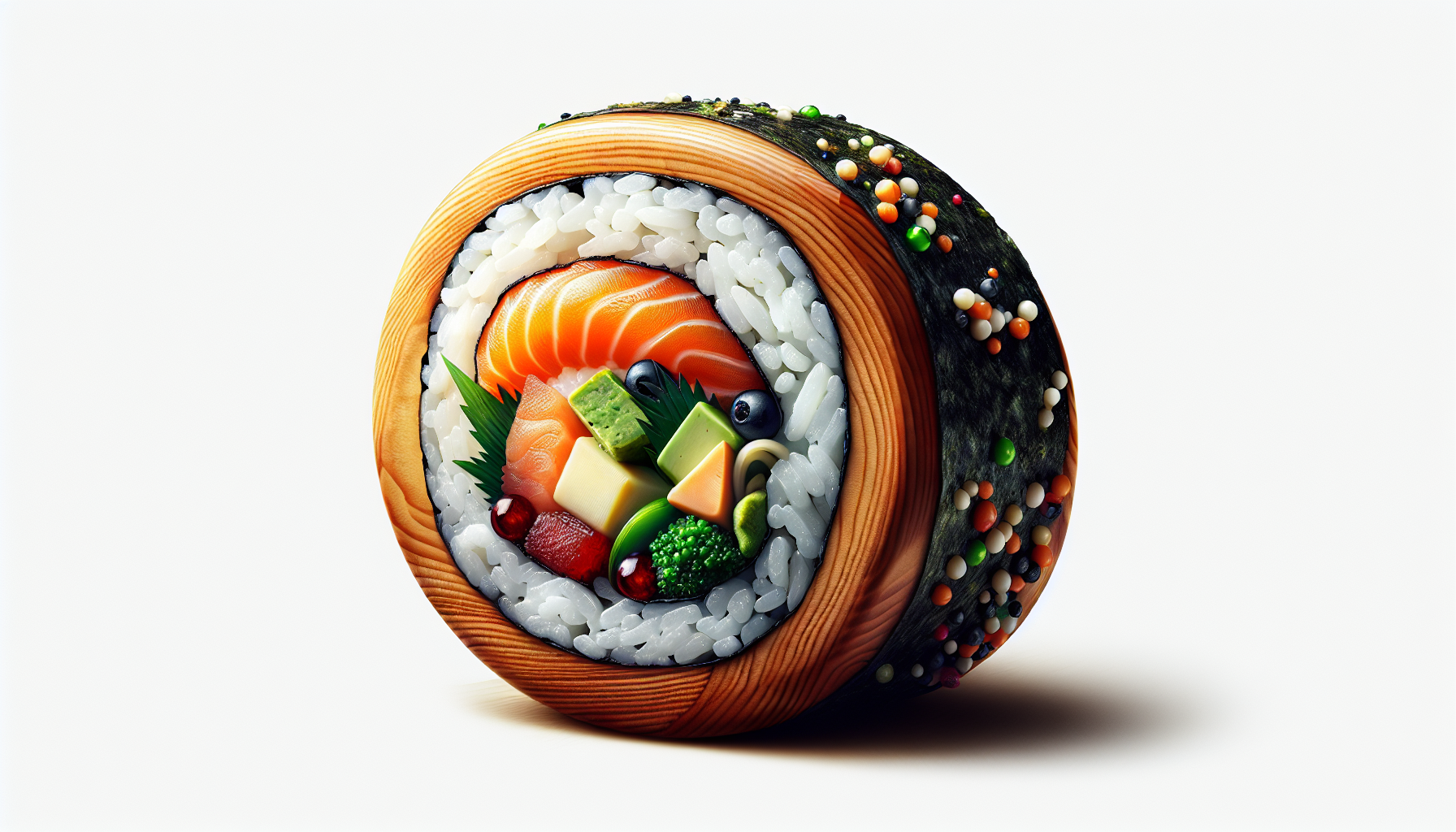Are you ready to elevate your sushi game? Look no further! In our article “The Perfect Sushi Rolling: Techniques And Tips,” we have everything you need to become a sushi master in your own kitchen. Whether you’re a seasoned chef or a beginner, our expert cooking tips and techniques will help you roll sushi like a pro. From selecting the freshest ingredients to mastering the delicate art of rolling, our comprehensive guide will take you step-by-step through the process. So get your bamboo mat ready and prepare to impress your friends and family with the perfect sushi rolls!

Choosing the Right Ingredients
When it comes to making sushi rolls, using the right ingredients is crucial to achieving the perfect result. Fresh and high-quality fish should be at the top of your list. It’s important to source your fish from a reputable supplier and ensure it is sushi-grade. This means that the fish has been handled and stored properly to maintain its freshness and quality.
In addition to fish, the selection of vegetables you choose for your rolls can greatly impact the flavor and texture. Opt for fresh and crispy vegetables such as cucumber, avocado, and carrot. These vegetables can add a refreshing crunch to your rolls and complement the flavors of the fish.
Lastly, don’t forget about the rice. Quality rice is the foundation of any good sushi roll. Look for a short-grain variety like Japanese sushi rice. This type of rice has the perfect amount of stickiness to hold your rolls together. Avoid using long-grain or jasmine rice, as they don’t have the same texture and stickiness needed for sushi.
When it comes to wrapping your rolls, nori seaweed sheets are essential. These thin sheets of seaweed add a savory flavor and help hold everything together. Look for high-quality nori sheets that are crisp and dark green in color.
Preparing the Rice
Preparing the rice is a critical step in sushi rolling. Choosing the right rice variety will greatly impact the overall texture and taste of your rolls. Japanese sushi rice is the recommended choice due to its stickiness and ability to hold shape.
After selecting the rice, proper washing and soaking are essential. This helps remove excess starch and ensures the rice cooks evenly. Start by rinsing the rice under cold water until the water runs clear. Then, let the rice soak in water for about 30 minutes before cooking.
Cooking the rice requires precision. Follow the instructions on the rice package, ensuring you measure the correct ratio of water to rice. Use a rice cooker or a pot with a tight-fitting lid to ensure even cooking. Once cooked, allow the rice to rest for a few minutes to achieve the perfect texture.
Seasoning the rice with sushi vinegar is the final step in preparing it for sushi rolling. Sushi vinegar can be made by combining rice vinegar, sugar, and salt. Gently fold the sushi vinegar into the cooked rice using a wooden or plastic rice paddle. Be careful not to overmix, as this can make the rice mushy.

Assembling the Sushi Rolling Essentials
To properly roll sushi, you’ll need a few essential tools. The first is a sushi rolling mat, also known as a makisu. This mat is made from bamboo and is used to roll and shape the sushi. It provides structure and helps create a tight roll.
Plastic wrap is another handy tool that can make rolling sushi easier. By wrapping the mat in plastic wrap, you prevent the rice from sticking to the mat and ensure a smooth rolling process.
A sushi rice paddle is a must-have tool for evenly spreading the rice on the nori sheet. Its flat surface and gentle handling prevent the rice from clumping or becoming too compacted.
Lastly, a sharp knife is necessary for cutting the rolls into bite-sized pieces. A dull knife can crush the rolls and make the presentation less appealing. Invest in a high-quality, sharp knife specifically designed for sushi cutting.
Preparing the Fillings
The fillings you choose for your sushi rolls are entirely up to you and your taste preferences. When it comes to fish, it’s important to slice it into thin and even pieces. This ensures that the fish is easy to bite into and provides a harmonious texture with the rice.
For vegetables, slicing them thinly and uniformly is important. It helps create a balanced and consistent roll. Cucumber, avocado, and carrot are popular choices due to their fresh flavors and contrasting colors.
If you want to add some variety to your rolls, consider marinating some of the fillings. Marinating fish or vegetables in soy sauce, mirin, or other seasonings can infuse them with additional flavor and enhance the overall taste of the roll.
Don’t be afraid to get creative with your fillings. You can experiment with different combinations of fish, vegetables, and even add-ons like cream cheese or tempura. Just keep in mind that the fillings should be in harmony with each other and the sushi rice.

Mastering the Rolling Technique
Rolling sushi can be a bit tricky at first, but with practice, you’ll soon master the technique. Here’s a step-by-step guide to help you roll like a pro:
- Place the nori sheet shiny side down on the plastic-wrapped sushi rolling mat.
- Wet your hands with water to prevent the rice from sticking. Take a handful of sushi rice and evenly spread it over the nori, leaving a small border at the top for sealing.
- Position the fillings in a line along the bottom edge of the nori, ensuring they are evenly distributed.
- Using the mat as a guide, start rolling the nori and fillings away from you. Apply firm but gentle pressure to ensure the roll is tight and compact.
- Once the roll is complete, use your fingers to apply pressure along the seam to seal it.
- Finish the roll by giving it a final firm roll using the sushi mat. This helps shape and tighten the roll.
Creating Different Sushi Styles
Sushi comes in various styles, and each style has its unique characteristics. Here are a few popular sushi styles you can try:
Maki Rolls
Maki rolls are the most common type of sushi rolls. They consist of a sheet of nori wrapped around sushi rice and fillings. The rolls are usually cut into bite-sized pieces and can be served as an appetizer or main course.
Uramaki Rolls
Uramaki rolls, also known as inside-out rolls, have the rice on the outside and the nori on the inside. These rolls are often coated with sesame seeds or other toppings for added texture and flavor.
Nigiri Sushi
Nigiri sushi consists of a small mound of sushi rice topped with a slice of fish or other fillings. It is a more simple and traditional style of sushi that allows the taste of the fish to shine.
Temaki Hand Rolls
Temaki hand rolls are cone-shaped sushi rolls that are wrapped by hand. They are filled with sushi rice, fish, and vegetables and are meant to be eaten in one or two bites. Temaki hand rolls are a fun and interactive way to enjoy sushi.
Oshi Sushi
Oshi sushi, also known as pressed sushi, is a style where sushi rice and toppings are pressed into a wooden mold to create a compact and uniform shape. This style of sushi often includes cured fish and is popular in Japan.
Cutting and Presentation
Once you’ve rolled your sushi, it’s time to cut it into bite-sized pieces and present it beautifully. Here’s how to do it:
Using a sharp knife, moisten the blade with water to prevent sticking. This also helps achieve cleaner and more precise cuts.
For maki rolls, cut them into six to eight equally-sized pieces. Start by cutting the roll in half, then cut each half into thirds or quarters.
For uramaki rolls, the cutting process is similar to maki rolls. However, you may want to wipe the knife with a damp cloth between cuts to maintain a clean appearance.
Arrange the cut sushi pieces on a serving plate to make them visually appealing. You can garnish with sliced ginger, wasabi, or even a sprinkle of sesame seeds for an extra touch.
Pairing with Dipping Sauces
No sushi experience is complete without dipping sauces. Here are a few common dipping sauces that pair well with sushi:
Soy Sauce
Soy sauce is a classic choice for dipping sushi. Its salty and umami flavors enhance the overall taste of the rolls. Dip your sushi pieces lightly into the soy sauce to avoid overpowering the delicate flavors.
Wasabi and Pickled Ginger
Wasabi and pickled ginger are often served alongside soy sauce. Wasabi adds a spicy kick to your sushi, while pickled ginger provides a refreshing palate cleanser between bites.
Spicy Mayo
For those who enjoy a bit of heat, spicy mayo is a popular choice. It combines mayonnaise and sriracha sauce to create a creamy and spicy dip that pairs well with a variety of sushi rolls.
Eel Sauce
Eel sauce, also known as unagi sauce, is a sweet and savory sauce made from soy sauce, mirin, and sugar. It is commonly used on eel or seafood rolls to add a rich and flavorful glaze.
Ponzu Sauce
Ponzu sauce is a citrus-based sauce made from soy sauce and citrus juice, usually lemon or lime. It adds a tangy and refreshing element to sushi rolls, especially those with seafood or vegetable fillings.
Tips for Beginners
If you’re new to sushi rolling, here are a few tips to help you get started:
Start with Simple Fillings
Begin with simple fillings like cucumber or avocado. These are easy to slice and handle, making the rolling process more manageable. As you gain confidence, you can experiment with more complex fillings.
Practice Rolling with a Dry Run
Before adding the rice and fillings, practice rolling with just the nori sheet. This allows you to get a feel for the process and ensure you have the technique down before assembling the roll.
Use Plastic Wrap for Easier Rolling
Wrapping the sushi mat with plastic wrap eliminates the risk of rice sticking to the mat. This makes the rolling process smoother and prevents the roll from falling apart.
Don’t Overfill
It’s essential not to overfill your sushi rolls. Overfilling can make them difficult to roll and may cause the roll to burst or unravel. Opt for a moderate amount of fillings to ensure a tight and well-formed roll.
Apply Even Pressure
When rolling sushi, apply even pressure to ensure a compact and well-shaped roll. Uneven pressure can result in a loose or unevenly-shaped roll. Take your time and press firmly but gently to achieve the desired results.
Common Sushi Rolling Mistakes to Avoid
Even with the best intentions, mistakes can happen when rolling sushi. Here are some common pitfalls to avoid:
Using Stale Ingredients
Ensure your ingredients, especially fish, are fresh and of high quality. Using stale fish can not only affect the taste but also pose health risks.
Not Properly Seasoning the Rice
The rice is the star of sushi rolls, and properly seasoning it is crucial. Take the time to season the rice with sushi vinegar to achieve the perfect balance of flavors.
Overstuffing the Roll
Resist the temptation to overstuff your rolls with fillings. Overfilling can lead to difficulty in rolling and a messy presentation. Remember, less is more when it comes to sushi.
Rolling Too Loose or Too Tight
Finding the right balance in rolling can be challenging. Rolling too loose can cause the roll to fall apart, while rolling too tight can result in a dense and unappetizing roll. Practice and experimentation will help you achieve the perfect balance.
Cutting with a Dull Knife
Using a dull knife to cut sushi rolls can crush the delicate ingredients and make the presentation less appealing. Invest in a sharp, high-quality knife specifically designed for cutting sushi.
With these tips and techniques in mind, you are well on your way to creating the perfect sushi rolls. Remember, practice makes perfect, so don’t be discouraged if your first attempts aren’t flawless. With time and patience, you’ll become a sushi rolling pro, impressing family and friends with your culinary skills. Enjoy your homemade sushi and have fun experimenting with different fillings, flavors, and presentation styles!

